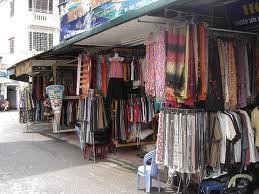VietNamNet Bridge – Bat Trang pottery, Ha Dong silk craft villages have been
flooded with Chinese goods. Meanwhile, the Dong Ho painting village not only has
lost its traditional career, but lost its name as well.
Chinese products dominating Vietnamese traditional craft villages
Part 2: Ha Dong silk is made in… China?

The problem is that Chinese goods are dirt cheap, which explains why Vietnamese
people still spend money on Chinese goods, even though they know that the
products have low quality.
Two years ago, Hanoi was busy preparing for the great festival to celebrate the
1000th anniversary of Thang Long – Hanoi establishment. At that time, Bat Trang
potteries and Van Phuc silk in Ha Dong were displayed at cultural events, which
were described as the “cultural envoys” to Vietnamese and foreign visitors.
Van Phuc silk showed how the craftsmen of the capital city are clever with their
hands. Noisy campaigns were launched at that time to make the products more
popular to travelers, domestic and foreign.
Nowadays, Van Phuc silk village is still bustling with profuse silk products
available. However, visitors now can see the sorrow in the eyes of the old
craftsmen who fear that the traditional handicraft may be lost in oblivion one
day.
Like in Bat Trang village, a lot of weaving workshops in Van Phuc village have
to shut down because their products cannot compete with cheap Chinese silk
industrial products. Some workshops have been struggling to survive, trying to
maintain production. However, they import fiber and dying chemical substances
from China to reduce the production costs.
The silk shops in Van Phuc village are still bustling with full visitors.
However, the majority of the products available are made in China, not made in
Van Phuc.
“Most of the weaving workshops in the village have shut down. How can there be
so much silk for sale?” Van, the owner of a weaving workshop in Van Phuc said.
“Even Van Phuc village cannot stand any more amid the difficulties, let alone
other craft villages,” she continued. “As a result, the silk products introduced
by the sellers as Van Phuc silk, in fact, come from China.”
The people in Van Phuc village also said that looking for real Van Phuc silk
products now is a difficult job like “looking for a needle in a haystack.”
Meanwhile, foreign made silk products are always in plenty which have been
introduced as the products from Malaysia, Thailand and Taiwan. However,
craftsmen have affirmed that all the products are from China.
“Van Phuc village now look like a market that sells silk products with different
sources, rather than a traditional weaving village. The biggest bitterness is
that Van Phuc silk has been defeated right in their home land,” said Nguyen Van
Sinh, Chair of the Van Phuc Silk Craft Village Association.
China made votive papers harm Dong Ho paintings
Unlike other craft villages, the craftsmen in the traditional Dong Ho folk
woodcut painting in Thuan Thanh district of Bac Ninh province do not have to
compete with Chinese products. However, big tragedy still has come: most of the
craftsmen here have given up their career of making folk woodcut painting.
There are only two craftsmen in the village who still make paintings – Nguyen
Dang Che and Nguyen Huu Sam.
Dong Ho Village’s people are getting richer every day with their new job of
making votive papers.
It was the Chinese merchants who made local people give up the traditional
handicraft. Dong Ho has disappeared in the thoughts of people.
Source: NLD